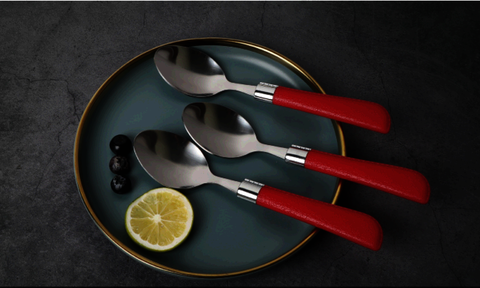Pulished on Mar. 18, 2022
Knives and forks, as one of the daily tableware, are most commonly used in the West. Knives are used to cut meat, and forks are used to send meat into the mouth, which is elegant and convenient. Knives and forks have now entered the homes of ordinary people. How much do you know about the history and culture of knives and forks?
![%M2J7$}H[TO{}0TG]N3P~)R.png %M2J7$}H[TO{}0TG]N3P~)R.png](https://www.garboflatware.com/data/upload/ueditor/20220318/62345a3b73e7a.png)
In fact, the earliest use of knives and forks was not in Western countries, but in China in the east of the earth. The earliest table knife discovered in the world was unearthed at the Hemudu site in Zhejiang, dating back about 7,000 years. People called the table knife at that time "dagger", which means delicious. In China, due to eating habits, chopsticks appeared in the Shang Dynasty, which gradually replaced the knife and fork and became popular among the people. And when did Western knives and forks start to be used? Some scholars believe that it was in the 10th century AD, when many oriental civilizations spread to the west, and tableware was no exception. Europe is dominated by animal husbandry, and the staple food is beef and mutton. Knives can not only kill sheep, dissect, and cut beef and mutton, but also serve as tableware after cooking the meat. Due to the practicality of knives and forks, knives and forks have gradually spread in the West.
The basic principle of holding a knife and fork is to hold a knife or spoon in the right hand and a fork in the left. When eating with a knife and fork, you should use a fork to fix the left side of the food, then use a knife to cut the food into small bites, and then dip the fork into the seasoning and send it into your mouth. When using the knife and fork, it should be noted that the knife edge is always inward. If the knife and fork need to be temporarily put down halfway through the meal, the knife and fork should be placed on the plate in a figure-eight shape, indicating that they will continue to eat.
In the West, knife and fork have multiple meanings. First of all, the function of the knife and fork is to cut. The cutting action from big to small cultivates the logical thinking of Westerners from the outside to the inside. Secondly, the cutting of knives and forks represents power; in addition, knives and forks are metal objects, which are non-renewable and limited resources in the natural environment. While satisfying their own needs, Westerners express the digging and possession of resources, and the pursuit of resources. Profit and profit; finally, the knife and fork are one-way cooperation with both hands, the emphasis is on fighting the world in a group, and the team spirit is advocated.

Seeing this, how much have you learned about the cultural knowledge of knives and forks? Knives and forks, as a product series created by Garbo, of course, there are also some involving different cultural backgrounds in different countries and regions. Interested friends, please feel free to click the chat window to consult us!
Looking for Flatware Supplier?
OEM&ODM RequestRequest for Quotation?
Get Factory PriceAny Confusion?
Speak With SalesmanWe deliver the quality and value your flatware needs, on time and within budget.
Contact UsODM&OEM Service
Our flatware is certified by leading retailers including Walmart, Tesco, Costco, Lidl, Target, and METRO, ensuring the highest quality standards.
Experience seamless service from design to export with our one-stop solutions. Our team simplifying your export process and allowing you to focus on growing your business.
Choose from a range of eco-friendly and customized packaging options to suit your specific needs. Our packaging solutions are designed to protect your products while reducing environmental impact.
Our efficient supply chain ensures timely delivery of your custom cutlery, minimizing lead times and keeping your business operations running smoothly.
Comprehensive support & satisfaction guaranteed.